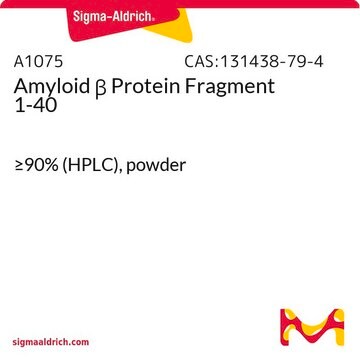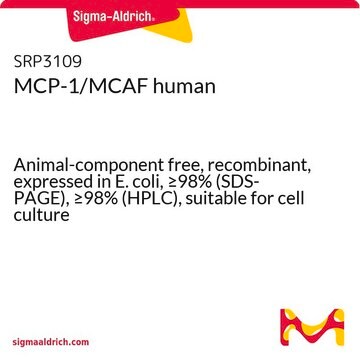All Photos(1)
About This Item
Empirical Formula (Hill Notation):
C203H311N55O60S1
Molecular Weight:
4514.04
UNSPSC Code:
12352200
NACRES:
NA.32
Recommended Products
Assay
≥95% (HPLC)
form
lyophilized
composition
Peptide Content, ≥75%
storage condition
protect from light
storage temp.
−20°C
Amino Acid Sequence
Ala-Ile-Val-Val-Gly-Gly-Val-Met-Leu-Gly-Ile-Ile-Ala-Gly-Lys-Asn-Ser-Gly-Val-Asp-Glu-Ala-Phe-Phe-Val-Leu-Lys-Gln-His-His-Val-Glu-Tyr-Gly-Ser-Asp-His-Arg-Phe-Glu-Ala-Asp
Application
Amyloid β (Aβ) refers to peptides derived from Amyloid precursor protein that vary in length from 36-43 amino acids. Aβ(s) peptides, their peptide fragments and mutated fragments are used to study a wide range of metabolic and regulatory functions including activation of kinases, regulation of cholesterol transport, function as a transcription factor, and regulators of inflammation. Aβ(s) peptides and their peptide fragments are also used to study oxidative stress, metal binding and mechanisms of protein cross-linking in the context of diseases such as Alzheimer′s disease and neurodegeneration.
Storage Class Code
11 - Combustible Solids
WGK
WGK 3
Flash Point(F)
Not applicable
Flash Point(C)
Not applicable
Certificates of Analysis (COA)
Search for Certificates of Analysis (COA) by entering the products Lot/Batch Number. Lot and Batch Numbers can be found on a product’s label following the words ‘Lot’ or ‘Batch’.
Already Own This Product?
Find documentation for the products that you have recently purchased in the Document Library.
S M Yatin et al.
Neurobiology of aging, 20(3), 325-330 (1999-12-10)
The amyloid beta-peptide (A beta)-associated free radical oxidative stress model for neuronal death in Alzheimer's disease (AD) brain predicts that neuronal protein oxidation is a consequence of A beta-associated free radicals [8]. In this study we have used both in
Kodeeswaran Parameshwaran et al.
Synapse (New York, N.Y.), 61(6), 367-374 (2007-03-21)
The brains of Alzheimer's disease (AD) patients have large numbers of plaques that contain amyloid beta (Abeta) peptides which are believed to play a pivotal role in AD pathology. Several lines of evidence have established the inhibitory role of Abeta
Yujie Zheng et al.
Pharmaceutics, 14(3) (2022-03-27)
Genipin has attracted much attention for its hepatoprotective, anti-inflammatory, and neuroprotection activities. However, poor water solubility and active chemical properties limit its application in food and pharmaceutical industries. This article aimed to develop a lipid-based microemulsion delivery system to improve
U Igbavboa et al.
Neuroscience, 142(3), 655-660 (2006-08-15)
Amyloid beta-protein (Abeta) increases apolipoprotein E (apoE) levels in astrocytes which could alter lipid trafficking. The mechanism for the Abeta-induced increase in apoE levels is not well understood. It is well established that stimulation of beta-adrenergic receptors (betaARs) increases cAMP
Lin Wang et al.
Journal of Alzheimer's disease : JAD, 64(3), 957-971 (2018-07-12)
Alzheimer's disease (AD) is characterized by neuritic plaques and neurofibrillary tangles. It is reported that enzymatic degradation of amyloid-β (Aβ) plays a pivotal role in Aβ accumulation and type-2 cannabinoid receptor (CB2R) participates in Aβ processing in the brain; however
Our team of scientists has experience in all areas of research including Life Science, Material Science, Chemical Synthesis, Chromatography, Analytical and many others.
Contact Technical Service


![[Gln22]-Amyloid β 1-40 human ≥95% (HPLC)](/deepweb/assets/sigmaaldrich/product/images/707/874/59f84b84-17c2-494f-b2ae-4ca860b83976/640/59f84b84-17c2-494f-b2ae-4ca860b83976.jpg)




